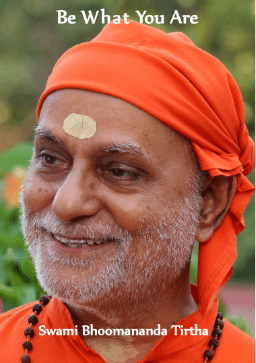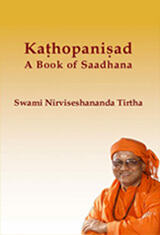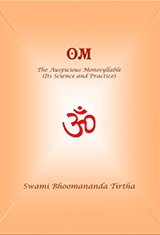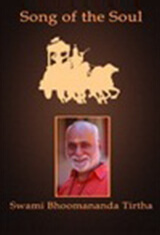Resources
25 | On Bhagavad Gita | Samatva – the essence of Bhagavad Gita
Swami Bhoomananda Tirtha

Take away from your mind, O Arjuna, all sense of difference about the spiritual pursuit. It is the mind and intelligence that work in both cases. In Jñāna-niṣṭhā, they become very specific and exclusive. And in Karma-niṣṭhā, their application is broad, including all activities of worldly life. So, remove even the least sense of difference between the two niṣṭhās. For, they have the same emphasis as well as goal. Each will take the seeker to the same spiritual goal of inner fullness, abundance and ecstasy.
Dear and blessed souls:
Harih Om Tat Sat.
Samatva – even attitude – the essence of Bhagavad Gita
Now, we go to the 3rd chapter of Bhagavad Gita. In fact, Krishna has already said whatever he wanted to and concluded the dialogue in the previous chapter itself. He described Sāṅkhya yoga, the practice of Upanishadic knowledge relating to the non-dual Brahman. As a corollary, he also explained Karma yoga. The essence of both consists in adopting an even attitude (samatva) in the mind towards all the dvandvas in one’s life and world.
All dvandvas evoke only two mental responses, namely sukha and duḥkha. In Sāṅkhya, what the seeker does is to adopt an even attitude, equipoise, towards transitory sukha-duḥkhas. In yoga, Karma yoga, the same even attitude is adopted to siddhi and asiddhi, fruition and non-fruition or success and failure of one’s effort. In both cases it is our mind’s spiritual attitude that is handled and reformed.
Thus, the seeming external difference between Sāṅkhya and Yoga has no consequence. Because, mind is the experiencing factor and it remains even in both pursuits. This is a fundamental point that every student and seeker should unfailingly grasp and be guided by. But, as it was for Arjuna, clarity and precision in understanding are rather hard to gain. This naturally gives rise to Arjuna’s question, marking the beginning of the next chapter of the dialogue.
Grief opens the door for spiritual and philosophical analysis
Spend a little time to ponder over both Sāṅkhya and Yoga and gain the necessary clarity about them. Arjuna’s question only helps students and seekers to reflect upon the subject with sufficient depth and attention.
The question is quite pertinent: “If you, O Krishna, consider that pursuit of Sāṅkhya-buddhi is superior to that of activity, (as you have indicated in verse 2.49), then why do you exhort me to engage in this most fierce act of fighting this colossal war?”
War, as an activity, differs from all the rest of actions. In war, the fighter’s sole aim is to kill his enemy. So far as Mahabharata war was concerned, all the 4.5 million fighters were to be killed one after another, except the very few who had survived in the end. Is there anything more tormenting? So, Arjuna still feels that he should not cause such a colossal bloodshed.
Arjuna’s question is obviously very relevant, warranting the attention of all seekers and students. This is how the dialogue extends, enhancing its scope and purpose. From grief and the need to assuage it, Arjuna’s quest, you will find, grows deeper, broader and loftier. In all instances where the mind is driven to adversity during interaction with the world and the question is taken up for discussion, it invariably becomes a full subject for spiritual and philosophical analysis. This is characteristic of the Indian thought-process.
Rama’s dilemma – a call for enlightenment
In the case of Arjuna, it is a case of battlefield and the confrontation it posed. In the 16-year-old Sri Rama’s case, it was the dejection and depression he encountered at the end of his long pilgrimage of this holy land. He had fought no war. He had just completed his learning in archery. Still, the plight evoked a thorough discussion, dialogue, from Sage Vasishtha, involving 32,000 Sanskrit verses of Yogavasishtha Ramayana. Vasishthadeva has covered all problems of human mind, providing solution
to them all from the enlightened intelligence. The whole dialogue is a memorable knowledge journey.
See, how the 18-day dialogue from morning to evening dealt with the agitation and torment of the human mind as a whole. In any instance of this kind, no matter from where and for what purpose the discussion begins, it soon incorporates philosophical and spiritual dimensions – a point seekers should especially cherish and assimilate without fail. See, how the war-field dialogue imbibes greater depth, vastness and loftiness.
Yearning for spiritual felicity – śreyas
Arjuna is quite sensitive and perhaps even apologetic in raising his question. With all humility he submits that the trouble is not in Krishna’s words of instruction, but in his own understanding of their message. Thus, in the next verse (3.2) he confesses: “Krishna, it appears that you are, by using conflicting words, apparently confusing my intelligence. At least, this is what it looks to be. Therefore, tell me precisely with clarity what is the means I should follow to attain śreyas, everlasting goodness. What I am yearning for is supreme spiritual felicity (śreyas), no matter, whether I am in the midst of this colossal war or not.”
Arjuna’s question makes his fundamental and ultimate need very clear. The enquiry gives sufficient ground for Krishna to deal with the subject, providing clarity not only to Arjuna, but also to all seekers anywhere in the world, any time.
Krishna discusses the subject with all thoroughness, so much so that the whole of the 3rd chapter is devoted to it. The chapter is named Karma Yoga. It discusses everything about the place and purpose of activity in human life, explaining how indispensable and fulfilling activity and interactions are for the welfare of oneself as well as the society at large.
One pursuit with two phases
Right from the most ancient times, through various teachers, says Krishna, it has been explained that there is only one dedicated pursuit, but it has two distinct phases. For those who are ardently given to introspection and that alone, it is called Jñānaniṣṭhā, the exclusive wisdom-path. For the rest, given to normal secular activities, it is the path of action (Karma Yoga).
It is like a river being called by different names as it flows through different regions. Though the water in it remains the same, flowing all the while, in the higher terrains the river is narrow but powerful, while as it descends to lower plateaus, it turns broader and gentler. The water itself is holy and divine throughout. Same is the case with Sāṅkhya-niṣṭhā (Jñāna Yoga) and Karma-niṣṭhā (Karma Yoga).
Impersonal dimension of the Knower
Mark Krishna’s words, which are very revealing (3.3): “By me was taught in the most ancient times, this niṣṭhā in two phases.” What does this signify? To identify oneself as ever-existing is characteristic of Knowers of this land. The Self, the ‘I’, is one alone. It is eternal, all-pervading and ever the same, as Krishna has explained in verses 2.12, 20, 24, 30. Bodies alone are different. Whoever has taught this science, knowledge, in him was the same Self, as in Krishna. Is not the space single, the same everywhere? Self too is like that.
This dialogue, a Brahmavidya discussion, transpired over 5000 years ago. Vyasadeva documented it right then. But Vedic Upanishads were evolved in the ageless past. Evidently, Brahmavidya was in vogue ever since. Krishna quotes Kathopanishad and Brahma-sūtras. Thus, in his saying that he, as the Self, had taught it right from ancient times is quite understandable.
The ancient wisdom
For instance, Mundakopanishad tells us that Brahmā taught Brahmavidya to his sons. His sons imparted the same to their children. And Angiras got it in succession. Shounaka, a great householder, living in the plains, was a staunch ritualist. He found no use in what he was doing. For, there was no visible response from those whom the rituals were addressed to. Feeling disgusted, not getting any guidance from those around, he went to Sage Angiras living in a hermitage in the woods and submitted: “By knowing which can I know everything in full?”
This is how the Upanishads lead us to true spiritual wisdom.
In Kathopanishad, Yama discloses to young Nachiketas the undying nature of the Soul that animates the human body.
Sage Ashtavakra imparts the same Soul-knowledge to King Janaka, who was ruling Mithila.
All these indicate how yogic wisdom was in vogue in this great land right from the remotest past. Krishna identifies with all these exponents, because though their bodies were different and many, the Self in all of them is One alone. It is natural for any true Knower to have this kind of full identity and to say what Krishna says.
In Brihadaranyaka Upanishad, Yajnavalkya explains to his wives how the Self is to be contemplated upon and realized. Depending upon the competence and ripeness of the seeker, the Teacher will make his emphasis on Jñāna-niṣṭhā or Yoga-niṣṭhā. This is the only difference.
Priyavrata was a good and noble king. As part of his efficient rule, he had to punish the wicked and reward the virtuous. Punishment often involved beheading the criminal. That part tormented the king deeply and he felt extremely dispassionate and wanted to abandon the throne, to live in the forest, get absorbed in austere contemplation and attain the supreme state of spiritual enlightenment and fulness.
Śrīmad Bhāgavata says that Brahmā came down and instructed Priyavrata that his subjects still needed his impartial rule. To neglect the throne and plunge the subjects to anarchy would not be right at all. To set matters right, Brahmā then imparted the science of Brahmavidya, enlightening the king’s intelligence and relieving the mind of all torments. As desired by Brahmā, Priyavrata remained on the throne and continued to rule, but without being overpowered either by sukha or duḥkha.
The singular goal of Jñāna and Action
This is how Krishna says he had instructed right from the most ancient days the singular Brahma-niṣṭhā, both in its exclusively contemplational and interactional phases.
“So”, says Krishna, “take away from your mind, O Arjuna, all sense of difference about the spiritual pursuit. It is the mind and intelligence that work in both cases. In Jñāna-niṣṭhā, they become very specific and exclusive. And in Karma-niṣṭhā, their application is broad, including all activities of worldly life.
Karma-niṣṭhā embraces all activities as the source for all of them is mind-intelligence. So, I want you to take away from your mind even the least sense of difference between the two niṣṭhās. For, they have the same emphasis as well as goal. Each will take the seeker to the same spiritual goal of inner fullness, abundance and ecstasy.

“All dvandvas evoke only two mental responses, namely sukha and duḥkha. In Sāṅkhya, what the seeker does is to adopt an even attitude, equipoise, towards transitory sukha-duḥkhas. In yoga, Karma yoga, the same even attitude is adopted to siddhi and asiddhi, fruition and non-fruition or success and failure of one’s effort. In both cases it is our mind’s spiritual attitude that is handled and reformed. ”
“To identify oneself as ever-existing is characteristic of Knowers of this land. The Self, the ‘I’, is one alone. It is eternal, all-pervading and ever the same. Is not the space single, the same everywhere? Self too is like that.”
“The essence of both Sāṅkhya yoga and Karma yoga consists in adopting an even attitude (samatva) in the mind towards all the dvandvas in one’s life and world. ”
“The seeming external difference between Sāṅkhya and Yoga has no consequence. Because, mind is the experiencing factor and it remains even in both pursuits. This is a fundamental point that every student and seeker should unfailingly grasp and be guided by.”
“In all instances where the mind is driven to adversity during interaction with the world and the question is taken up for discussion, it invariably becomes a full subject for spiritual and philosophical analysis. This is characteristic of the Indian thought-process. ”
“Right from the most ancient times, it has been explained that there is only one dedicated pursuit, but it has two distinct phases. For those who are ardently given to introspection and that alone, it is called Jñānaniṣṭhā, the exclusive wisdom-path. For the rest, given to normal secular activities, it is the path of action (Karma Yoga). ”
you might be interested in

Swami Bhoomananda Tirtha
135 – Bhagavad Gita – Swami Bhoomananda Tirtha – Knowledge alone destroys all sin

Ma Gurupriya
2 – Interactive Satsang with Ma Gurupriya

Swami Bhoomananda Tirtha
099 – Bhagavad Gita – Swami Bhoomananda Tirtha – Freedom lies in acting without Doership

 209 views
209 views

 Add to Favorites
Add to Favorites Add to Reading List
Add to Reading List






